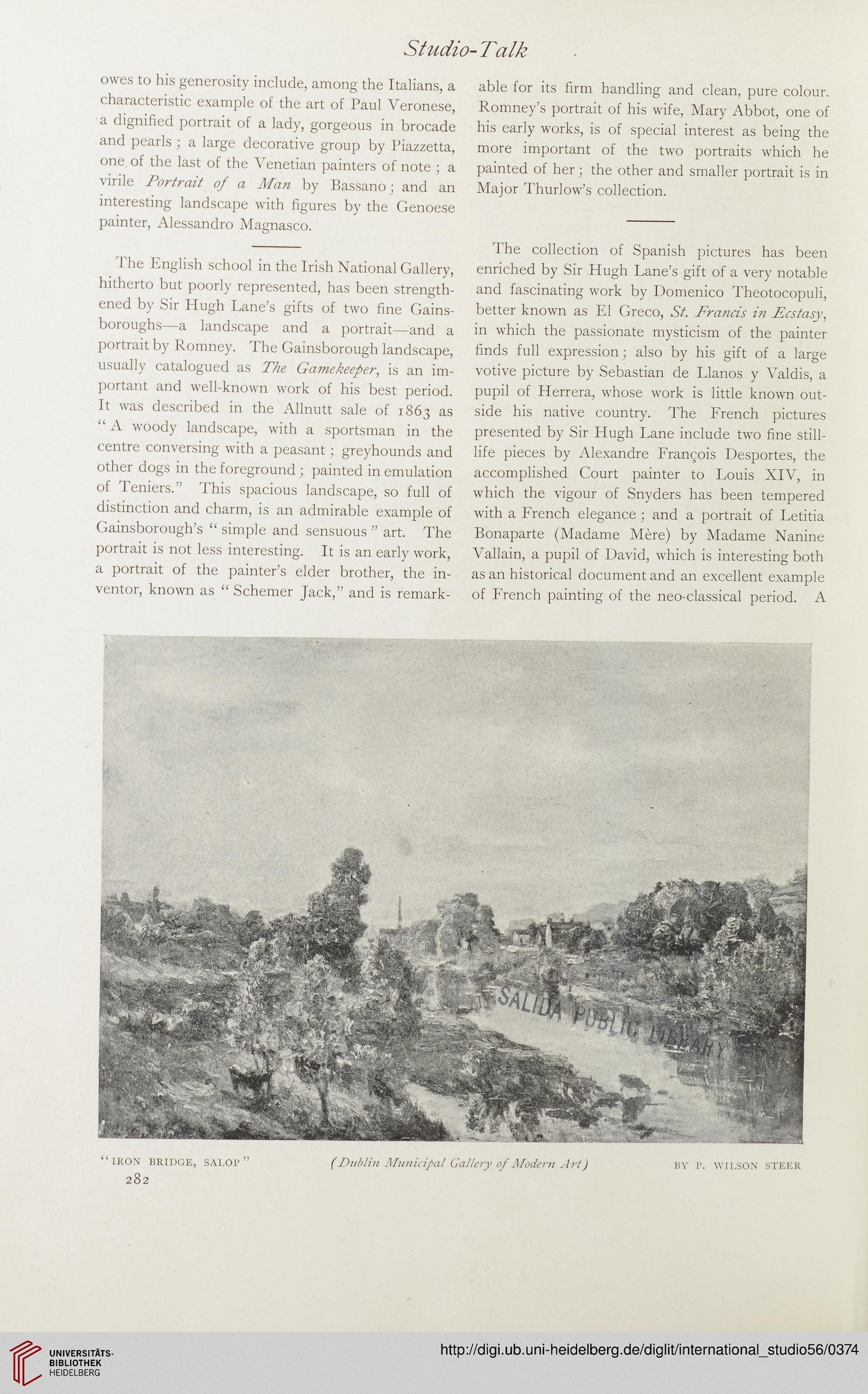Studio-Talk
owes to his generosity include, among the Italians, a
characteristic example of the art of Paul Veronese,
a dignified portrait of a lady, gorgeous in brocade
and pearls ; a large decorative group by Piazzetta,
one of the last of the Venetian painters of note ; a
virile Portrait of a Man by Bassano; and an
interesting landscape with figures by the Genoese
painter, Alessandro Magnasco.
The English school in the Irish National Gallery,
hitherto but poorly represented, has been strength-
ened by Sir Hugh Lane’s gifts of two fine Gains-
boroughs—a landscape and a portrait—and a
portrait by Romney. The Gainsborough landscape,
usually catalogued as The Gamekeeper, is an im-
portant and well-known work of his best period.
It was described in the Allnutt sale of 1863 as
“ A woody landscape, with a sportsman in the
centre conversing with a peasant; greyhounds and
other dogs in the foreground ; painted in emulation
of Teniers.” This spacious landscape, so full of
distinction and charm, is an admirable example of
Gainsborough’s “ simple and sensuous ” art. The
portrait is not less interesting. It is an early work,
a portrait of the painter’s elder brother, the in-
ventor, known as “ Schemer Jack,” and is remark-
able for its firm handling and clean, pure colour.
Romney’s portrait of his wife, Mary Abbot, one of
his early works, is of special interest as being the
more important of the two portraits which he
painted of her; the other and smaller portrait is in
Major Thurlow’s collection.
The collection of Spanish pictures has been
enriched by Sir Hugh Lane’s gift of a very notable
and fascinating work by Domenico Theotocopuli,
better known as El Greco, St. Francis in Ecstasy,
in which the passionate mysticism of the painter
finds full expression; also by his gift of a large
votive picture by Sebastian de Llanos y Valdis, a
pupil of Herrera, whose work is little known out-
side his native country. The French pictures
presented by Sir Hugh Lane include two fine still-
life pieces by Alexandre Francois Desportes, the
accomplished Court painter to Louis XIV, in
which the vigour of Snyders has been tempered
with a French elegance ; and a portrait of Letitia
Bonaparte (Madame Mere) by Madame Nanine
Vallain, a pupil of David, which is interesting both
as an historical document and an excellent example
of French painting of the neo-classical period. A
“iron bridge, salop”
282
(Dublin Municipal Gallery of Modern Art)
BY P. WILSON STEER
owes to his generosity include, among the Italians, a
characteristic example of the art of Paul Veronese,
a dignified portrait of a lady, gorgeous in brocade
and pearls ; a large decorative group by Piazzetta,
one of the last of the Venetian painters of note ; a
virile Portrait of a Man by Bassano; and an
interesting landscape with figures by the Genoese
painter, Alessandro Magnasco.
The English school in the Irish National Gallery,
hitherto but poorly represented, has been strength-
ened by Sir Hugh Lane’s gifts of two fine Gains-
boroughs—a landscape and a portrait—and a
portrait by Romney. The Gainsborough landscape,
usually catalogued as The Gamekeeper, is an im-
portant and well-known work of his best period.
It was described in the Allnutt sale of 1863 as
“ A woody landscape, with a sportsman in the
centre conversing with a peasant; greyhounds and
other dogs in the foreground ; painted in emulation
of Teniers.” This spacious landscape, so full of
distinction and charm, is an admirable example of
Gainsborough’s “ simple and sensuous ” art. The
portrait is not less interesting. It is an early work,
a portrait of the painter’s elder brother, the in-
ventor, known as “ Schemer Jack,” and is remark-
able for its firm handling and clean, pure colour.
Romney’s portrait of his wife, Mary Abbot, one of
his early works, is of special interest as being the
more important of the two portraits which he
painted of her; the other and smaller portrait is in
Major Thurlow’s collection.
The collection of Spanish pictures has been
enriched by Sir Hugh Lane’s gift of a very notable
and fascinating work by Domenico Theotocopuli,
better known as El Greco, St. Francis in Ecstasy,
in which the passionate mysticism of the painter
finds full expression; also by his gift of a large
votive picture by Sebastian de Llanos y Valdis, a
pupil of Herrera, whose work is little known out-
side his native country. The French pictures
presented by Sir Hugh Lane include two fine still-
life pieces by Alexandre Francois Desportes, the
accomplished Court painter to Louis XIV, in
which the vigour of Snyders has been tempered
with a French elegance ; and a portrait of Letitia
Bonaparte (Madame Mere) by Madame Nanine
Vallain, a pupil of David, which is interesting both
as an historical document and an excellent example
of French painting of the neo-classical period. A
“iron bridge, salop”
282
(Dublin Municipal Gallery of Modern Art)
BY P. WILSON STEER




